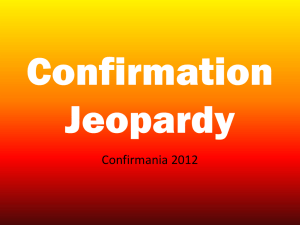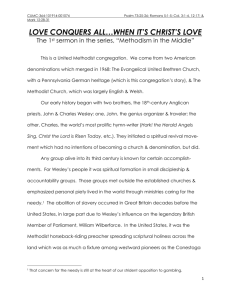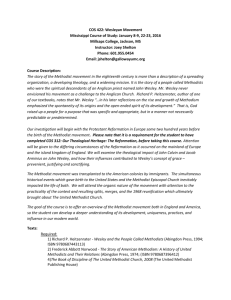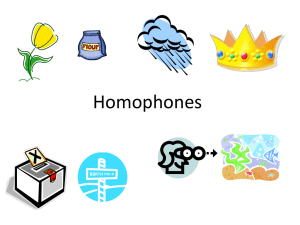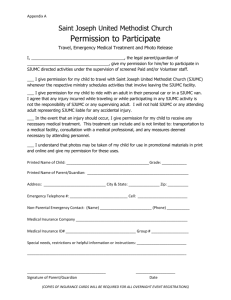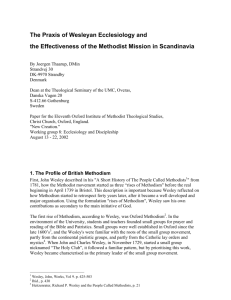to Syllabus - Upper New York Annual Conference of The
advertisement
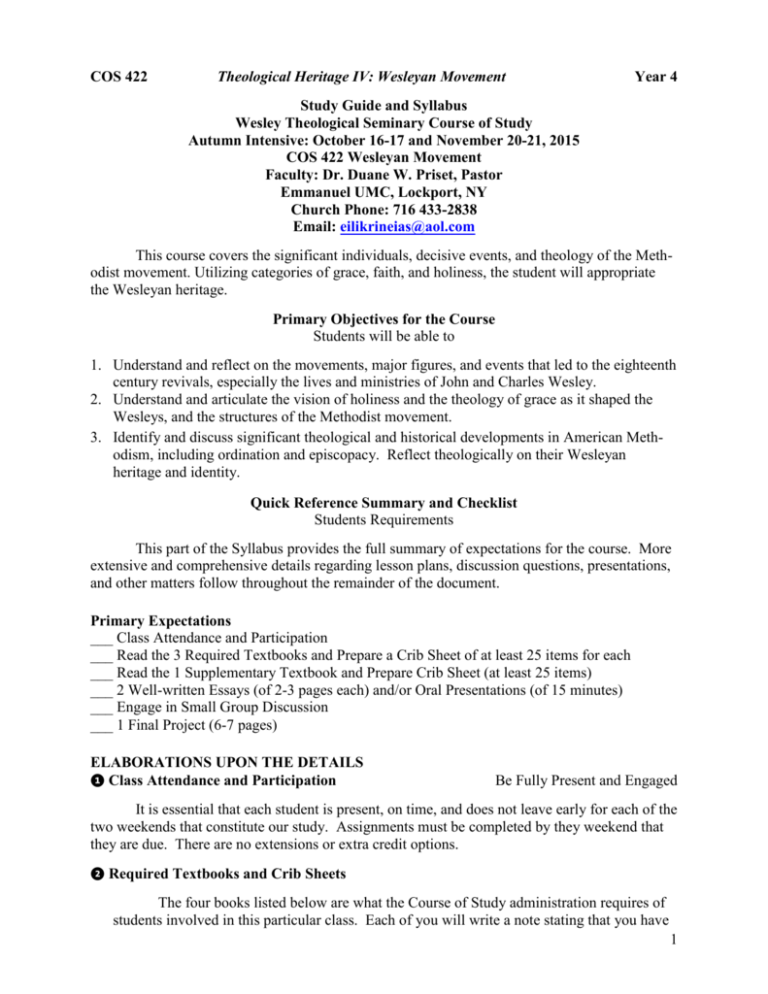
COS 422 Theological Heritage IV: Wesleyan Movement Year 4 Study Guide and Syllabus Wesley Theological Seminary Course of Study Autumn Intensive: October 16-17 and November 20-21, 2015 COS 422 Wesleyan Movement Faculty: Dr. Duane W. Priset, Pastor Emmanuel UMC, Lockport, NY Church Phone: 716 433-2838 Email: eilikrineias@aol.com This course covers the significant individuals, decisive events, and theology of the Methodist movement. Utilizing categories of grace, faith, and holiness, the student will appropriate the Wesleyan heritage. Primary Objectives for the Course Students will be able to 1. Understand and reflect on the movements, major figures, and events that led to the eighteenth century revivals, especially the lives and ministries of John and Charles Wesley. 2. Understand and articulate the vision of holiness and the theology of grace as it shaped the Wesleys, and the structures of the Methodist movement. 3. Identify and discuss significant theological and historical developments in American Methodism, including ordination and episcopacy. Reflect theologically on their Wesleyan heritage and identity. Quick Reference Summary and Checklist Students Requirements This part of the Syllabus provides the full summary of expectations for the course. More extensive and comprehensive details regarding lesson plans, discussion questions, presentations, and other matters follow throughout the remainder of the document. Primary Expectations ___ Class Attendance and Participation ___ Read the 3 Required Textbooks and Prepare a Crib Sheet of at least 25 items for each ___ Read the 1 Supplementary Textbook and Prepare Crib Sheet (at least 25 items) ___ 2 Well-written Essays (of 2-3 pages each) and/or Oral Presentations (of 15 minutes) ___ Engage in Small Group Discussion ___ 1 Final Project (6-7 pages) ELABORATIONS UPON THE DETAILS ❶ Class Attendance and Participation Be Fully Present and Engaged It is essential that each student is present, on time, and does not leave early for each of the two weekends that constitute our study. Assignments must be completed by they weekend that they are due. There are no extensions or extra credit options. ❷ Required Textbooks and Crib Sheets The four books listed below are what the Course of Study administration requires of students involved in this particular class. Each of you will write a note stating that you have 1 completed all (or what amount) of the required reading. Each required book is loaded with carefully articulated and extensive details. Take time for careful reading, comprehension, marking and enrichment. Making Crib Notes is a helpful means of marking details you may find interesting and meaningful for eventual recovery. See the sample Crib Sheet at the end of this syllabus. 1) Russell E. Richey, Kenneth E. Rowe, and Jean Miller Schmidt, American Methodism: A Compact History (Nashville: Abingdon Press, 2010, 2012, ISBN 978-1-4267-4227-9) Have book read before the October 16th and 17th classes and a crib sheet of at least 25 items prepared (see below) and presented to the professor also at the beginning of this first weekend intensive. 2) Richard P. Heitzenrater, Wesley and the People Called Methodists (Nashville: Abingdon Press, 1995, ISBN 0-687-01682-7) Have the book read before the November 20th and 21st classes and a crib sheet of at least 25 items prepared (see below) and presented to the professor also at the beginning of this second weekend intensive. 3) Randy Maddox, Responsible Grace: John Wesley’s Practical Theology (Nashville: Kingswood Books, An Imprint of Abington Press, 1994, ISBN 0-687-00334-2) Have the book read before the November 20th and 21st classes and a crib sheet of at least 25 items prepared (see below) and presented to the professor also at the beginning of this second weekend intensive. Crib Sheets: When reading each book, gather at least twenty-five words, phrases, or brief sentences (no lengthy excerpts), with accompanying page numbers. This exercise will preserve information you would want to reach back into at any later point of time. All in all, after reading the three required books, you should have gathered a total of at least seventy-five words, phrases and/or brief sentences, with corresponding page numbers. Moreover, these crib notes will fund some of our in-class sharing and discussion. Supplementary Text Also Required! 4) Read: John H. Wigger, Taking Heaven by Storm: Methodism and the Rise of Popular Christianity in America (Urbana and Chicago: University of Illinois Press, 2001 ISBN 10:025206994.3 (pbk.:alk.paper)/ISBN 13:978-0-252-06994-9. Have the book read before the October 16th and 17th classes and a crib sheet of at least 25 items prepared (see below) and presented to the professor also at the beginning of this first weekend intensive. ❸ Written Essays and/or Oral Presentations (Two to three pages each) Select two topics from the list below and, after clearing choices with the professor, prepare a 2-3 page written paper or a 15-minute oral presentation on each of your selected topics in British and/or American Methodism. Please keep to the 2-3 page or 15-minute parameters. One essay or oral presentation is due anytime during the October weekend and one essay or oral presentation due anytime during the November weekend. Except when using quotes, do not copy from books or the Internet Express the material in your own words Possible Topics a. With John Wesley’s life in review, differentiate the significant details pertaining to what is called the Three Rises of Methodism: (a) The First Rise – Oxford, (b) The Second Rise – Georgia, (c) The Third Rise – London. 2 b. There is a part of London called “Wesley’s Square Mile.” Drawing upon John Wesley’s life story from early on into old age, pinpoint and describe at least five of the geographical markers that “house” some part of his life story. c. Describe what is distinctive to Wesley’s view of salvation and how it differed from (a) the Moravians, (b) the Church of England, and (c) the Calvinists. d. Describe the primary differences between Methodism as it developed under John and Charles Wesley in Britain and then under Francis Asbury and others who led the church in America and altered its ways of spreading scriptural holiness throughout the land. e. Identify major figures in the United Brethren in Christ and the Evangelical Association churches and the roles they played in the development of these movements and their relationship with the Methodist Episcopal Church. f. Trace the heritage of Black Methodism in America, both inside and outside the Methodist Episcopal Church. Include an appraisal of the early days, the pre-Civil War years, the Reconstruction, and the 20th century. g. Describe what led to any one of the African Methodist Episcopal, African Methodist Episcopal Zion, Methodist Protestant, Wesleyan Methodist, or Methodist Episcopal South schisms and resulted with their respective separations from the Methodist Episcopal Church. h. Delineate the background story that led to the development and drafting of our Social Creed. Situate it in what was going on in American history at the time. i. Identify the element of United Methodist polity (church government) which you think stands as the most useful mark of its system. Contrast your view with what you think is the least useful feature of Methodist polity. (Feel free to limit your research to particular periods of time, e.g. 18th, 19th, 20th century Methodism). j. [Four Options] ① Following thirty years of estrangement, the Evangelical Association and the United Evangelical church reconciled as the Evangelical Church in 1922. ② Following approximately one hundred years of separation the Methodist Episcopal, Methodist Episcopal South, and Methodist Protestant churches united in 1939. ③ The United Brethren and Evangelical churches united in 1946. ④ The Evangelical United Brethren and Methodist Church became The United Methodist Church in 1968. Select any one of the four unions, reconstruct a piece of their history, and describe challenges their people faced once “the deal was done.” Keying off a book title, The Unfinished Church, by Bishop Paul Washburn, a key leader in the 1968 union, offer three suggestions you feel would make church unions – even of local churches – into healthier communities. k. John Wesley believed the living core of the Christian faith was revealed in Scripture, illumined by tradition, vivified in personal experience, and confirmed by reason. Articulate how these touch points become a means of enriching a growing sense of personal faith and congregational development. ❹ Small Group Discussions The Methodist Movement in America The First Intensive Weekend During our class discussion times, the class will break off into two or three small groups. Each group will engage in a different topic among the following choices. Afterwards, the small 3 groups will come back into the main group and share the gist of their talk and the insights gathered. i. Articulate the various ways in which Methodist people related to the conflict arising between Colonial America and Great Britain. And what was the development of John Wesley’s views on this subject? And how did it impact how Methodists in America were regarded by various people? ii. Using Wesley’s views for a starting point, discuss what you have learned about the development of people’s thoughts, the appearance and disappearance of statements in the Discipline, and the various currents and conflicts in pre-Civil War America pertaining to the holding and selling of slaves. Touch on how the American North and South handled the issue of whether or not to preach politics. Consider how slavery does or does not exist today. iii. Throughout the nineteenth century, American Methodism experienced a developmental journey as people shifted from gathering in small meeting houses and chapels to ornate churches. Meanwhile music, one among many other issues, played complementary and conflicting roles. Precursors to modern day music wars! List and describe the changes that have come to bear on people’s sense of community and engagement in ministry during this progression. iv. Scan through, do a rough outline of, highlight, and reflect upon Charles Albert Tindley’s classic sermon “Heaven’s Christmas Tree.” Born in slavery, illiterate into his late teens, Tindley responded to God's call upon his life and attracted great attention for his ministry among the poor, especially in late nineteenth- and early twentieth-century Philadelphia. Try an Internet search for a copy of the sermon. However, the instructor can provide copies for discussion purposes. v. The year 1956 is the year that the Methodist Church started ordaining women clergy. Slip back into the previous decades. Look across the various groups that have become United Methodist. Discuss the progression or digression of thoughts and some of the Scriptural underpinnings that eventually led to the ordination of women. Methodist Beginnings in Great Britain The Second Intensive Weekend i. One of the earliest experiences the Wesleys had in field preaching occurred while John stood upon his father’s grave and preached to the Epworth villagers. Recall some of the experiences that the Wesley family had for their thirty-nine years in Epworth. What seemed abusive! What seemed non-productive! Consider any of the good fruit that may have resulted. Go on to give examples of how Samuel and Susanna Wesley both impacted the lives of each of their children. ii. In terms of a book John Wesley’s father Samuel wrote, offering advice to those starting ministry (1735) – being led deep into the via media tradition of the Church of England (not Puritan, not Roman Catholic, and not Platonist) as initially expounded in Richard Hooker’s Laws of Ecclesiastical Polity (1595) – discuss the key resources upon which we might come to appropriately define true faith and practice. iii. By using the analogy of the porch, the door, and religion itself, as in Wesley’s “Principles of a Methodist Farther Explained,” what did Wesley regard as the experiential 4 doctrines of Methodism? Engage his thoughts about preceding, convincing, justifying and sanctifying grace? What did he mean by “loving God with all the heart, so that every evil temper is destroyed, and every thought and word and work springs from and is conducted to that end by the pure love of God and our neighbor”? iv. Scan through, do a rough outline of, highlight, and prepare to discuss one of two of John Wesley’s last and lesser known sermons – i.e., “On Living Without God” – Ephesians 2:12 and “On the Wedding Garment” – Matthew 22:12 (a Christian perfection sermon). Try an Internet search for copies of the sermons. However, the instructor can provide copies for discussion purposes. v. In a letter that John Wesley once wrote, he described the doctrine of full sanctification as “the grand depositum which God has lodged with the people called Methodists; and for the sake of propagating this [God] appeared to have raised us up.” Discuss and detail your understanding of the difference between Christian assurance and Christian perfection – both distinctively Methodist theological touch points. ❺ Final Project (Something to Pass On) According to a WXXI Rochester television program, “Crucible of Freedom,” Ken Burns’ has an intriguing description of history: History is the present-day attempt to put some order and reason around the chaotic events, which is the whole of human experience – indeed, the whole of all experience. We’re trying to tell ourselves stories that make sense to us, not just about the past but also about the present. All of life is just haphazard confluences of actions and people and personalities. History is the going back and picking up some of the pebbles on the beach and bringing them back to your collection (Ken Burns’ closing words in Crucible of Freedom, a production of WXXI Rochester, New York television, 1999). Drawing upon your reading, preparations for class, and discussion times, prepare a single informational presentation (an article, lesson plan, local church or area church history sketch, or other presentation) you believe would help a congregation understand and appreciate the identity, development and mission that they have (could have) as a church. I do not want this class to be just some academic exercise but something that can meaningfully engage your circle of ministry. Your informational presentation should be six or seven pages of conscientiouslyresearched, carefully-focused, well-written material due upon the last day we meet. Ⓐ Heritage Bio-Sketch Some Final Project Possibilities Delve into a heritage biography or research some information on any one of the following people – e.g., Susanna Wesley (1669-1742), Peter Cartwright (1785-1872), Benjamin T. & Ellen Roberts (respectively, 1823-1893 & 1825-1908), Frances Willard (1839-1898), G. Bromley Oxnam (1891-1963), or some other of your selection – detailing her/his significance. Keep the final draft to six or seven pages. Ⓑ Book Review Read George Eliot’s (Mary Ann Evans’) classic 1859 English novel Adam Bede. Follow the story line for Dinah Morris, Methodist lay preacher, in terms of her personal life, 5 relationships, call, preaching, prayer ministry, sense of compassion, and social witness. Your review should be a well-researched and well-crafted presentation of six or seven pages. Ⓒ Period of Time Center in upon a twenty-five year period of time for your local church / community of faith. It could be near the present day or from many years ago. Sleuth out and comb through a wide range of resources. Try to imagine how your community of faith is situated in the wider context of what it is going on in the wider world. Skim through available resources: e.g., local church materials, Conference journals, and local community/county histories. Interview parishioners, if it is possible. Enhance your investigation with an eye toward how insights and findings covered in this Theological Heritage study in the Wesleyan Movement might fund your project. Compose a six- or seven-page paper – nicely written – something that could become a chapter in your own local church history. Ⓓ Hymn Study Almost everyone enjoys one style of church music or another. Probe into the contextual, geographical, musical, and biographical backgrounds of some church song rooted in an aspect of the United Methodist tradition. Examples: Wesley hymns, camp meeting songs, gospel songs, spirituals, songs of protest and social unrest, or ethnic and cultural pluralism. Keep to the six- or seven-page asking of a carefully researched, devised, and articulated presentation – something that possibly could be a series for a church newsletter, devotional presentation, or Sunday school presentations. Feedback, Evaluation and Grades The Student Grade Sheet assigned to the instructors for student evaluation purposes conveys the following matters pertaining to grades: A 96-100 Superior Work A- 90-95 Excellent Work B+ 86-89 Very Good B 83-85 Average B- 80-82 Below Average C 78-79 Needs Improvement C- 75-77 Meets Minimum Standards Below 75 Failing – No credit given Wesley Theological Seminary asks of its Course of Study instructors to keep in mind the following learning and evaluation perspectives: Overall Academic Performance: Critical thinking, Evidence of foundational knowledge and specific vocabulary of discipline, Preparation for class, Class participation, Evidence of theological depth, Evidence of engagement with different perspectives, and Evidence of mature response to criticism. Written & Oral Assignments: Correct grammar, spelling and sentence structure, Expansive vocabulary and illustration, Progression & coherence of argument / logical consistency, Appropriate citations and bibliography, Meets standards of assignments. Relational skills: Contributions to learning community, Interpersonal interaction, Self-awareness, Improvement/growth. Reverend Dr. Duane W. Priset eilikrineias@aol.com Adjunct Professor 6 A Sample THE CRIB SHEET Each book you are asked to read is loaded with many interesting and meaningful details. As you go through each chapter, jot down any words, phrases, brief sentences, and/or topics (no lengthy excerpts), with corresponding page numbers – something that you would find especially interesting, informative, and helpful. While doing this, you will be constructing your own collection of information pieces you might want for later recall. Write a Word, Phrase, Sentence or Topic Where Found: Chapter & Page(s) 1. ____________________________________________________________________________ 2. ____________________________________________________________________________ 3. ____________________________________________________________________________ 4. ____________________________________________________________________________ 5. ____________________________________________________________________________ 6. ____________________________________________________________________________ 7. ____________________________________________________________________________ 8. ____________________________________________________________________________ 9. ____________________________________________________________________________ 10. ___________________________________________________________________________ Student’s Name ___________________________ 7
